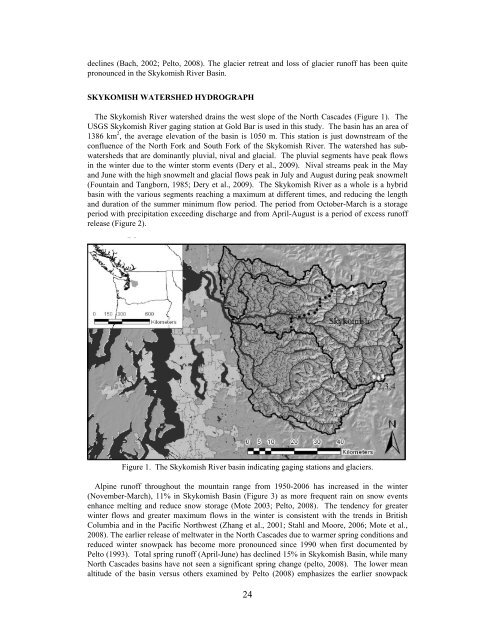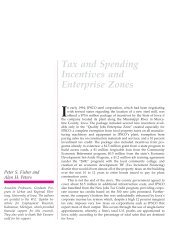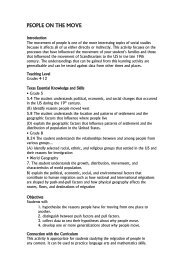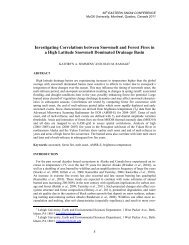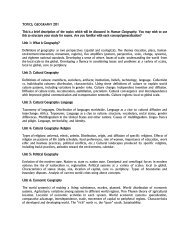Skykomish River, Washington Impact of Ongoing Glacier Retreat on ...
Skykomish River, Washington Impact of Ongoing Glacier Retreat on ...
Skykomish River, Washington Impact of Ongoing Glacier Retreat on ...
You also want an ePaper? Increase the reach of your titles
YUMPU automatically turns print PDFs into web optimized ePapers that Google loves.
declines (Bach, 2002; Pelto, 2008). The glacier retreat and loss <str<strong>on</strong>g>of</str<strong>on</strong>g> glacier run<str<strong>on</strong>g>of</str<strong>on</strong>g>f has been quite<br />
pr<strong>on</strong>ounced in the <str<strong>on</strong>g>Skykomish</str<strong>on</strong>g> <str<strong>on</strong>g>River</str<strong>on</strong>g> Basin.<br />
SKYKOMISH WATERSHED HYDROGRAPH<br />
The <str<strong>on</strong>g>Skykomish</str<strong>on</strong>g> <str<strong>on</strong>g>River</str<strong>on</strong>g> watershed drains the west slope <str<strong>on</strong>g>of</str<strong>on</strong>g> the North Cascades (Figure 1). The<br />
USGS <str<strong>on</strong>g>Skykomish</str<strong>on</strong>g> <str<strong>on</strong>g>River</str<strong>on</strong>g> gaging stati<strong>on</strong> at Gold Bar is used in this study. The basin has an area <str<strong>on</strong>g>of</str<strong>on</strong>g><br />
1386 km 2 , the average elevati<strong>on</strong> <str<strong>on</strong>g>of</str<strong>on</strong>g> the basin is 1050 m. This stati<strong>on</strong> is just downstream <str<strong>on</strong>g>of</str<strong>on</strong>g> the<br />
c<strong>on</strong>fluence <str<strong>on</strong>g>of</str<strong>on</strong>g> the North Fork and South Fork <str<strong>on</strong>g>of</str<strong>on</strong>g> the <str<strong>on</strong>g>Skykomish</str<strong>on</strong>g> <str<strong>on</strong>g>River</str<strong>on</strong>g>. The watershed has subwatersheds<br />
that are dominantly pluvial, nival and glacial. The pluvial segments have peak flows<br />
in the winter due to the winter storm events (Dery et al., 2009). Nival streams peak in the May<br />
and June with the high snowmelt and glacial flows peak in July and August during peak snowmelt<br />
(Fountain and Tangborn, 1985; Dery et al., 2009). The <str<strong>on</strong>g>Skykomish</str<strong>on</strong>g> <str<strong>on</strong>g>River</str<strong>on</strong>g> as a whole is a hybrid<br />
basin with the various segments reaching a maximum at different times, and reducing the length<br />
and durati<strong>on</strong> <str<strong>on</strong>g>of</str<strong>on</strong>g> the summer minimum flow period. The period from October-March is a storage<br />
period with precipitati<strong>on</strong> exceeding discharge and from April-August is a period <str<strong>on</strong>g>of</str<strong>on</strong>g> excess run<str<strong>on</strong>g>of</str<strong>on</strong>g>f<br />
release (Figure 2).<br />
Figure 1. The <str<strong>on</strong>g>Skykomish</str<strong>on</strong>g> <str<strong>on</strong>g>River</str<strong>on</strong>g> basin indicating gaging stati<strong>on</strong>s and glaciers.<br />
Alpine run<str<strong>on</strong>g>of</str<strong>on</strong>g>f throughout the mountain range from 1950-2006 has increased in the winter<br />
(November-March), 11% in <str<strong>on</strong>g>Skykomish</str<strong>on</strong>g> Basin (Figure 3) as more frequent rain <strong>on</strong> snow events<br />
enhance melting and reduce snow storage (Mote 2003; Pelto, 2008). The tendency for greater<br />
winter flows and greater maximum flows in the winter is c<strong>on</strong>sistent with the trends in British<br />
Columbia and in the Pacific Northwest (Zhang et al., 2001; Stahl and Moore, 2006; Mote et al.,<br />
2008). The earlier release <str<strong>on</strong>g>of</str<strong>on</strong>g> meltwater in the North Cascades due to warmer spring c<strong>on</strong>diti<strong>on</strong>s and<br />
reduced winter snowpack has become more pr<strong>on</strong>ounced since 1990 when first documented by<br />
Pelto (1993). Total spring run<str<strong>on</strong>g>of</str<strong>on</strong>g>f (April-June) has declined 15% in <str<strong>on</strong>g>Skykomish</str<strong>on</strong>g> Basin, while many<br />
North Cascades basins have not seen a significant spring change (pelto, 2008). The lower mean<br />
altitude <str<strong>on</strong>g>of</str<strong>on</strong>g> the basin versus others examined by Pelto (2008) emphasizes the earlier snowpack<br />
24


